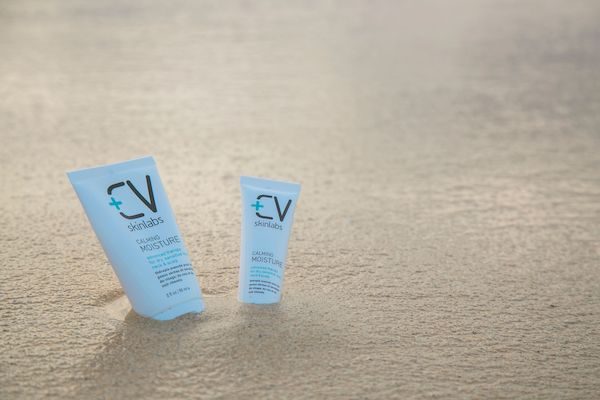In the summertime, we all tend to think a little bit more carefully about skin sun protection.
But it can be confusing.
Does SPF matter? Which sunscreen is best? Are some harmful to the skin? What about chemical vs. physical formulations?
In this post, we tackle the most common myths out there, giving you the information to make the safest choice for you and your family.
Skin Sun Protection Myth #1: The Sun Must Never Touch Your Skin!
Here in the U.S., we’re a little sun obsessed. We’re always talking about wearing sunscreen to protect from skin cancer and delay the appearance of aging.
In general, this is good advice. But it is a myth that you must never allow the sun to touch your skin. The truth is that we need the sun in small doses. And many of us aren’t getting enough.
According to scientific research, Americans are deficient in vitamin D—the vitamin the skin makes when exposed to the sun. One study showed that the overall prevalence of vitamin D deficiency in the U.S. was nearly 42 percent. Researchers saw the highest rates in African Americans (82.1 percent) followed by Hispanics. (69.2 percent).
Meanwhile, mounting evidence suggests that vitamin D deficiency could be linked to several chronic diseases. These include cardiovascular disease and cancer, as well as thin, brittle bones.
You can get some vitamin D from food, but not enough to meet the body’s needs. Supplements can help. But the sun is our best source. When ultraviolet rays hit the skin, special receptors in the skin synthesize vitamin D3. This is the most “natural” form of the vitamin. Vitamin D, in turn, then goes on to help protect the skin from cellular damage, including damage from the sun itself.
According to scientists, the major cause of vitamin D deficiency is inadequate exposure to sunlight. “Wearing a sunscreen with a sun protection factor of 30 reduces vitamin D synthesis in the skin by more than 95 percent.” People with a naturally dark skin tone have some natural sun protection and require at least three to five times longer exposure to make the same amount of vitamin D as a person with a white skin tone.
Truth: You Need Some Sun
Truth: For your overall health, it’s best to get some sun exposure several times a week to meet your vitamin D needs. If you are extremely fair, burn easily, or have a medical condition that makes it risky to spend time in the sun, talk to your doctor about vitamin D supplements.
- In the summer (when you’re wearing short sleeves and shorts and more skin is exposed to the sun), 8-10 minutes of sun exposure at noon can be sufficient for those with lighter skin; those with darker skin will need more time.
- In the winter (when more of the skin is covered with clothing), nearly 2 hours of sun exposure at noon may be needed.
- Where you live can be a factor—those in the northern latitudes with a greater distance from the sun will need more time than those closer to the equator.
Skin Sun Protection Myth #2: A High SPF Means I Can Stay Out Longer
SPF numbers are confusing to most consumers. It would seem that an SPF of 50 would offer almost twice as much protection as an SPF of 30, allowing you to enjoy more time in the sun. But that’s not how it works.
SPF refers to the protection against UVB rays and how long you can be exposed before the skin starts to burn. The amount of time it takes the skin to burn without sunscreen multiplied by the SPF equals the number of minutes you can spend in the sun without burning if the sunscreen is properly applied.
Truth: An SPF of 15 blocks 93 percent of UVB rays. An SPF of 30 blocks 97 percent and an SPF of 50 about 98 percent. Regardless of the number, it’s necessary to reapply sunscreen every 90 minutes at least. Reapply more often if you’re exposed to water or you’re sweating.
The American Academy of Dermatology (AAD) recommends an SPF of at least 30, noting that anything higher is typically unnecessary. The organization suggests getting a broad-spectrum sunscreen that offers protection against UVA and UVB rays in a water-resistant formula. They add that high-number SPFs last the same amount of time as low-number SPFs:
“A high-number SPF does not allow you to spend additional time outdoors without reapplication.”
Skin Sun Protection Myth #3: Sunscreen Is the Only Option
With all the marketing for sunscreen, many of us believe that is the only option when it comes to protecting our skin from sun damage. But that’s not true.
Truth: Sunscreen can’t completely protect against UV rays, even if you apply it perfectly and reapply when necessary. Even the highest SPF can block only about 99 percent of UV rays. It starts to wear down the minute after you put it on.
The best way to protect your skin from sun damage is to use multiple approaches. Start with physical protection. Options include protective clothing, trees (for shade), hats, umbrellas, sunglasses, and sun shelters. Clothing with UPF designation will offer even more protection. (The number indicates the fraction of the sun’s UV rays that can penetrate the fabric.)
Avoiding time outside when the sun is brightest (10:00 a.m. to 4:00 p.m.) is also a good option. Then add your favorite sunscreen product and reapply as needed.

Skin Sun Protection Myth #4: All Sunscreen Is Safe
For many years we didn’t think much about what ingredients were in our sunscreen.
That all changed when the U.S. Food and Drug Administration (FDA) released the results of studies showing that so-called chemical sunscreens were absorbed into the skin more than previously believed. These include avobenzone, oxybenzone, octocrylene, and ecamsule.
In a 2019 study, the FDA found that in the four sunscreens tested, the active ingredients were absorbed at higher levels than those deemed safe by the FDA. In a 2020 study of six ingredients from another four commercially available sunscreen products, they found the same results. Oxybenzone was absorbed far more readily than any of the other ingredients.
The Centers for Disease Control and Prevention (CDC) found that 97 percent of Americans have oxybenzone circulating in their bodies. Other studies have indicated that chemical sunscreens—those that work like a sponge to absorb the sun’s rays—may have the ability to alter hormone function in the human body.
Physical sunscreens, on the other hand, like zinc oxide and titanium dioxide, work like a shield. They sit on the surface of the skin and deflect the sun’s rays. They are less likely to be absorbed into the skin.
Truth: We need more research to determine whether chemical sunscreen ingredients may harm the skin or body. Meanwhile, it’s best to play it safe and choose those formulas with physical sunscreens like zinc oxide and titanium dioxide.
We recommend you refer to the Environmental Working Group’s (EWG’s) guide to sunscreens for more help in choosing the best one for you and your family.
Do you have any concerns about sunscreen?






